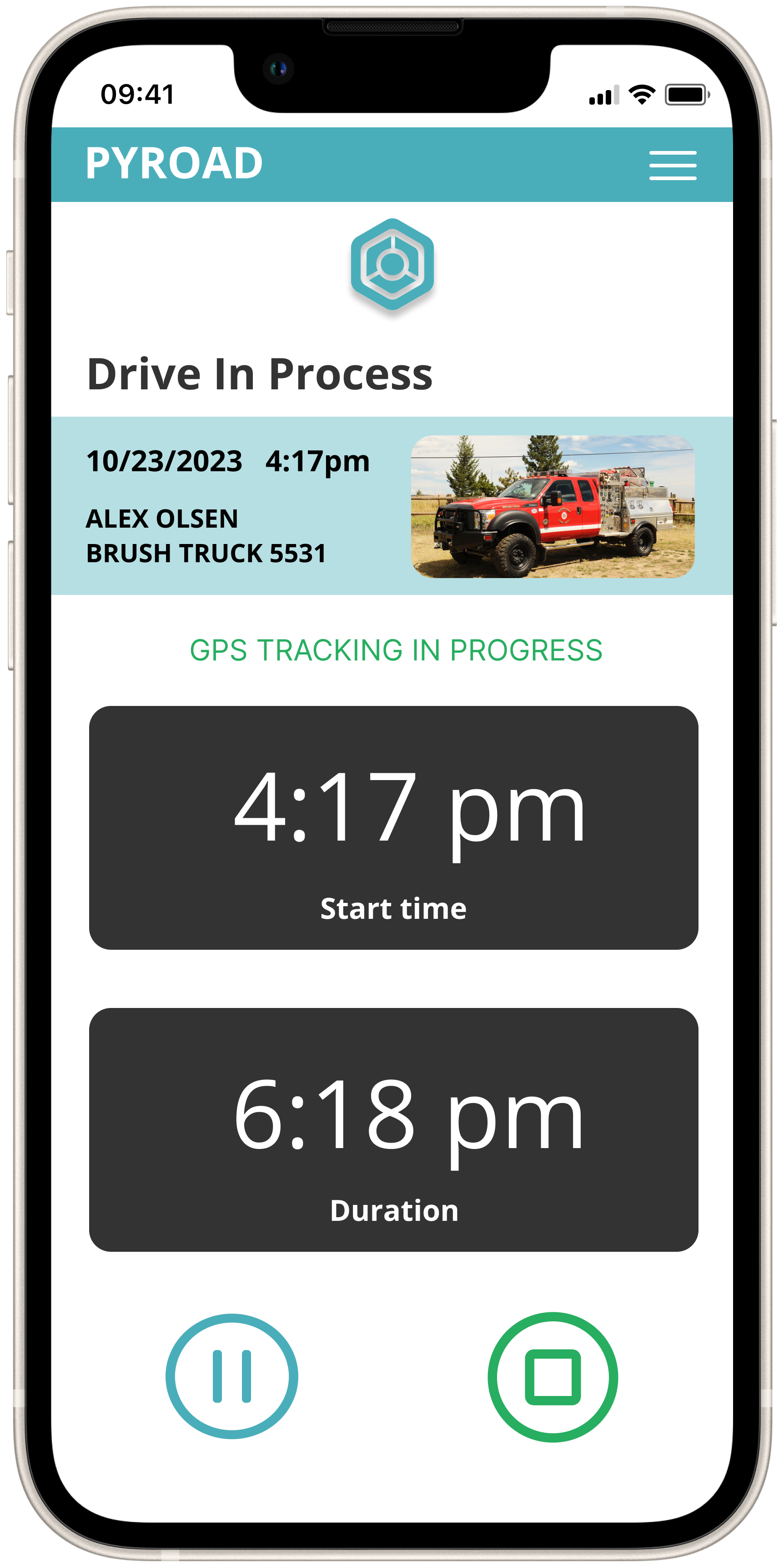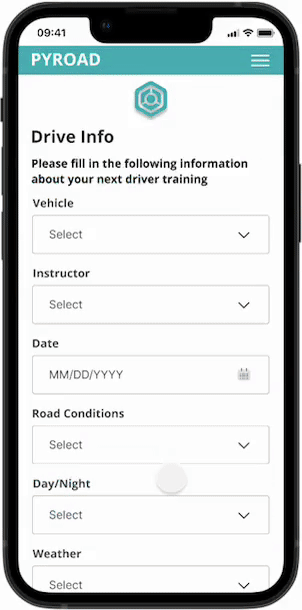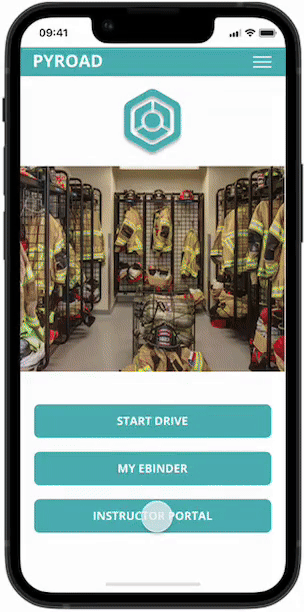
PYROAD
Mobile first responsive website
User Research
UX/UI Design
Prototype and User Testing
12 Weeks
Tools: Figma, FigJam, Zoom, Otter AI, Bing Copilot
Background
Out of the 1,041,200 firefighters in the US, 65% are volunteers and typically do not have the experience that career firefighters do.
Volunteer fire firefighters with little to no commercial driving experience are expected to learn and drive large sophisticated apparatus. These include Water Tenders, Fire Engines, Utility Terrain Vehicles, Medical Rescue and Brush Trucks.
There is a federal exception that allows firefighters to drive the various apparatus without the need for any special drivers licenses.
Problem
There are often people assigned to drive a fire apparatus who may not have the required training or have not demonstrated that they can truly perform the task.
This places not only department members at risk but also the public they serve.
Driving fire apparatus is a very serious activity with very real repercussions. It is owed to the safety of the crew and community that it is treated responsibly.
Pyroad is a mobile first responsive website that makes community’s safer by assiting volunteer fire departments in training emergency vehicle drivers.
Research
Goal
To explore the stumbling blocks that are in the way of a firefighter trainee so that departments and instructors can create more qualified emergency vehicle drivers.
Research Objectives
1. Understand how a trainee gets experience driving emergency vehicles.
2. Understand how fire departments stay complaint with local and federal laws.
3. Learn how driving experience is recorded and documented.
Research Plan
What else is out there?
I completed a competitive analysis of several existing driving applications.
Key Findings:
No firefighter specific product available
Many had very distracting adds, alerts and features
GPS element provides a level of sophistication
Promote atmosphere of safety
Ability to record road conditions and track drive
Assumption:
My general assumptions were that firefighters didn’t want to drive certain apparatus out of lack of time. I assumed I might have trouble having a firefighter open up due to insecurities of abilities, having individuals not open up for fear of legal implications of insufficient driving abilities or risk having participants not open up due perceived or projected repercussions and accountability of instructors.
Learning about existing users
Interviews
Qualitative interviews were conducted in person and via Google Meets. Confidentiality and privacy were crucial. The interviews lasted between 20 and 90 minutes.
Participants
5 firefighters between the ages of 27-76.
Included trainees, recent trainees and long term firefighters.
Interview sample questions:
What are your favorite things about driving department vehicles?
What are your least favorite things about driving department vehicles?
How would you rate your training experience with the vehicles on a scale of 1-10 and why?
What is it like to schedule drive times with instructors? What could be improved?
Are you done with training or would you like to add more vehicles? Why?
Tell me about what vehicles in particular you are not signed off on and why?
What do you think about your experience with driver training, specific truck in mind?
How are your training drives recorded, what information is included in that record?
Walk me through how you keep your driver training records.
How is your driver training documented with the department?
How do you think the process can be modernized?
Why do you think firefighters put off getting signed off on certain vehicles?
In what way can driver training be improved?
What would make you want to take vehicles out more frequently?
Where you ever rewarded for good driving behaviors?
Following the user interviews, I transcribed each session and organized the key points. Then by grouping common sentiments I identified key insights. After gathering key insights from all the interviews I explored if there were general themes or patterns. I noticed a couple repeating patterns that surfaced.
Affinity map
Observations
Modernization of Training: There's a common suggestion among 4 out of 5 of interviewees for modernizing the training process, possibly through technology or clearer documentation of procedures, to enhance efficiency and effectiveness. Improved documentation, including detailed checklists and easier access to personal training records, is suggested to streamline training and ensure consistency was expressed by 5 out of 5 interviewees.
Training Records: The methods for keeping training records vary, from personal binders to digitizing personal records. Some share with department some do not. There's a shared interest in making records more accessible and organized. Record keeping also seems to be lacking pertinent information that could be recorded, road conditions, drive routes, weather. Clearly expressed by 5 out of 5 interviewees.
Standardization: A repeated pattern emerged for a need to formalize the training process.
Expressed by 4 out of 5 interviewees.
Recording: Improved documentation, including detailed checklists and easier access to personal training records, is suggested to streamline training and ensure consistency
Feelings: Very strong feeling were shared regarding the seriousness of the responsibility of driver training, the rushed nature of the process and the time needed to achieve a level of comfort behind the wheel. Felt by 5 out of 5 firefighters.
Key takeaways
Participants have expressed several concerns regarding the paper binder system. One significant issue is its inability to facilitate feedback, limiting communication and collaboration among team members. Additionally, the challenge of obtaining signatures can become problematic, particularly if a binder is misplaced, leading to potential delays and complications in documentation.
The security of the records is another critical concern, as firefighters are required to maintain them, which may not always ensure their safety. This can pose risks related to confidentiality and data integrity. Furthermore, the current system appears to diminish overall participation when it comes to driving, as the cumbersome nature of managing paper records may discourage engagement.
Another notable drawback is the absence of vital information such as weather conditions, time of day, and road status. This lack of data can hinder decision-making processes and impact operational safety. Overall, participants feel that the paper binder system presents multiple challenges that could benefit from reevaluation or modernization.
Point of View statements
I’d like to explore ways to help volunteer firefighters record their driving training to further departments overall driver-ship and accountability.
I’d like to explore ways to help volunteer firefighters record their driving training because the current way seems inefficient and is discouraging qualified drivers.
Volunteer firefighters have a need for compiling training records in one place for easy access for the department and personal record keeping to be in compliance with local and state laws.
Sample sign off sheet
How Might We?
I came up with some HMW statements to begin to frame my potential solutions.
How might we make driver training be a more simplified process from scheduling to driver sign off?
How might we transform volunteers' paper records into a more complete and secure driver training record?
How might we utilize technology to document driver training more effectively?
Discovery
Defining the user
Personas
During the user research phase, I discovered common goals and pain points among participants, leading to identifying 3 distinct user types.
Experienced Veteran
Traditional old-timer
Trainee
User and Business Goals
The objectives of firefighters and businesses often converge in their shared commitment to safety, efficiency, and community service, fostering environments where prevention and preparedness are paramount.
What should be added?
Feature Set
A carefully crafted and prioritized catalogue of features was compiled to drive the project forward in a purposeful manner.
From concept to product
Site Map
I created a preliminary site map as the initial step to develop a well-structured foundation for an effective and seamless user experience.
User flow
User flows are created to provide a clearer and more detailed visualization of the actions taken by users as they navigate signing in and recording a drive.
Signing in
Record drive
Low fidelity and mid fidelity wireframes
With some quick hand sketches I began to strategize the overall feel and flow of the design.
Signing In
I transformed the simple drawings into more detailed digital designs, concentrating on three example user task sequences.
Recording a training drive
Final Vehicle Sign Off
Design
Style guide & UI Kit
High fidelity wireframes
Instructor has the ease of going over a users record at their own convenience, clear tasks are presented them in order of urgency.
Clear instructions provided, allowing accessibility for the variety of firefighters you might find at a volunteer department.
Informative modules allow a extra level of proficiency when gauging a firefighters abilities.
Instructor signing off a trainee.
A takeaway from 5 out of 5 the interviews is that any time to provide words of encouragement is greatly appreciated by firefighters.
A form for a verified electronic signature with added dated time stamp. Allows for remote verification based on 4 out of 5 participants.
Each users sequencing of vehicles is tailored to meet the departments needs in accordance with achievable goals based on each users abilities.
Recording a drive.
Stop watch records duration while the GPS tracks the drive in the background in a non distracting way. Simple single Stop Recording Button within thumbs reach.
Responsive feedback given when successful actions are completed.
Form field supplied to give users space to fill in supplemental information about a recorded drive based on 4 out of 5 participants.
Easy to use drop down menus allow rapid data entry.
Real time GPS tracking of training drive is included in the driving record. Desired by 5 out of 5 firefighters.
Ability to securely share users driving record with the fire department for safe keeping and compliance issues as expressed by 5 out of 5 interviewees.
Does it work?
Usability Testing
After the initial prototype was completed, Usability testing was preformed with 7 active firefighters.
3 of the firefighters also filled the role of driving instructors.
Ages range from 27 to 72.
The tests were done via zoom, as participants were recorded using the Figma prototype.
The two task flows all the participants executed were:
Documenting a training drive.
Getting a Final Sign off of a vehicle after completing all necessary items.
Results
Users enjoyed the simplicity of the prototype. 7 out of 7 felt it was a dramatic improvement from the antiquated binder although there were plenty of some stumbling blocks encountered.
Insights
Results from usability testing showed a repeating pattern of pain points and need for UI clarification.
These pain points occurred at the same places for the majority of participants.
Overall reactions were positive, 5 out of 7 expressed
Iterations
Post usability test
After valuable feedback was gathered from the usability tests, key iterations were preformed on the prototype. Over 11 iterations were made in the revised prototype.
Before
Before
Before
Sequencing
There was feedback as to why the prerequisites were treated with lower priority and not in sequential order. In the revision the prerequisites were elevated in order of priority.
Before
Instructor portal
The instructor portal through testing was a point of confusion for 4 out of 7 of the users. It wasn't clear that the view drive button was the next step after selecting a task. Prompts were added for clarification.
In the iteration completed tasks were removed. Users only wanted to see what they had to do right away. A button was added closer to the task list as opposed to having to scroll down to find it.
Before
Drive recording
Many of the participants weren't certain how to stop recording a drive. Some even expressed if a pause drive button is even necessary. I did away with the pause button which was a stumbling block for 4 out of 7 participants. The time duration is now expressed in hrs and minutes elapsed, eliminating any confusion with the older stop watch.
After
A home button was added alleviate a pain point experience by 3 out of 7 participants. and the view details stands out more as a CTA.
Home screen
Instructor home screen was consolidated into one screen. Removing a stumbling point experience by 3 out of 7 in the usability test.
After
After
The complete button was removed, once a drive is signed off a green border replaces the black one.
Before
After
After
After

Final prototype
Recording a training drive and requesting a final sign off.
Preforming a final sign off on a vehicle for a trainee.
Next steps
Moving forward, I would like to take the time to carefully revisit my feature priority list to ensure that all aspects are thoroughly evaluated and considered. It would be great to further develop other features and be ale to do usability testing on the in the field with firefighters. In future developments I would also be enjoy exploring how Pyroad could be integrated into other fire department software’s t become more of a holistic set of fire fighter tools.
















































